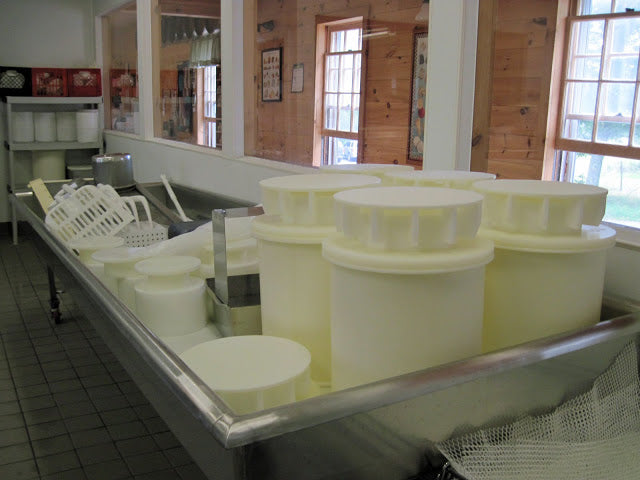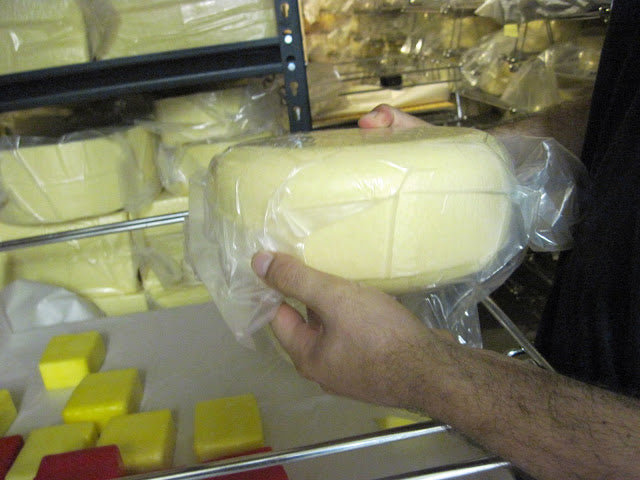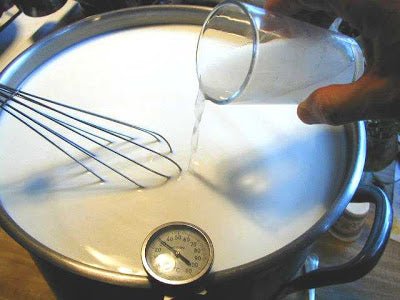Making Cheese the Way They Did 100 Years Ago!
It seemed like I drove forever to the middle of nowhere, where Vermont meets the end of the earth, to find Jesse Werner’s slice of heaven! The surprise was that I wasn’t the only one there.
Apparently, tourists from everywhere come in droves to see how cheese is made in a factory built by Calvin Coolidge’s father. (Yes, that’s the former President who actually set up a “Summer White House” in the upstairs of the general store down the street from the factory.)
Note: The Plymouth Cheese and Harvest Festival Sunday will be Sunday, September 19th from 10am-4pm. There will be cheese sampling by the Vermont Cheese Council, guided tours of the Plymouth Cheese Factory, wagon rides, historic farm and craft demonstrations, a cheese recipe contest, barbecue and more. Call the President Calvin Coolidge State Historic Site at 802-672-3773 for details.
I first met Jesse at the American Cheese Society’s Annual Conference in Seattle last week. Jesse was there, like many other cheesemakers, to meet buyers, make friends and taste good cheese.
He had entered two of his cheeses in the competition, (the Original Recipe category) so he will be getting good feedback soon in the mail (the judges give everyone who enters an evaluation).
Jesse didn’t expect to win a ribbon in the prestigious contest because he has only been making Plymouth Artisan Cheese for less than a year! That’s right- in one year, he has managed to set up his facility, including a retail store, produce over 900 pounds of cheese every week, enter the ACS cheese competition and attend his first conference in Seattle. Are you surprised to hear that he works seven days a week? And, he’s only 29!
Jesse first made cheese with an “old Greek guy who had goats” in his neighborhood in northern Vermont. This home cheesemaker had Kosikowski (
Cheese and Fermented Milk Foods) and he bought his rennet and cultures from a cheese plant near their neighborhood. He showed Jesse how to make Feta.
Jesse went on to get his MBA (Masters in Business Administration) from NY University in Prague, Czech Republic. He was deciding what business to go into and he thought of his Greek friend. He realized that making cheese is a fascinating business because it’s a start-to-finish process. So, he attended the Vermont Institute of Artisinal Cheeses at UVN and then apprenticed with a master cheesemaker. When he heard that the Plymouth factory was available, he wrote a proposal, got accepted and opened for business.
Setting up the facility wasn’t quite as hard as it would be ordinarily because Jesse leases the historic site from the State of Vermont and that includes the existing equipment. There are several other buildings in the village that are leased by the state, and there are tours of the area (beginning at the general store).
The cheese factory was originally built in 1890 by John Coolidge and it stayed in the family until 1998, when they donated it to the state. The purpose of the business was to use the abundant supply of cow’s milk in the area at a time when there was no other way to preserve it. Most of the cheese was shipped to Boston and sold as private labels.
The same recipe was always used and is still used by Jesse today. It’s a “stirred-curd” cheese which they traditionally called “granular curd.” Back then, however, the cultures were made by saving a little of the whey from each batch, heating it on the stove overnight and using it to start the next batch in the morning.
There is a retail store down the hall from the make rooms where they sell their three delicious cheeses- Hunter, East Meadow and Original Plymouth, as well as a large selection of other Vermont food products. They even sell our
Mozzarella Kits!
In the 1990’s the state put in observation windows, so the two large make rooms are completely visible to the public. (I noticed one older visitor who stayed glued to the observation window for at least 3 hours while the cheese was being made.)
Upstairs, there’s a Cheesemaking Museum with the old wooden vats and the original presses. On the walls are pictures of the Coolidge family and the history of the building. This is definitely a destination spot for history buffs.
Making the Cheese
I was lucky enough to be there when Jesse and his two fellow cheesemakers (Andy and Aaron) were starting a batch of cheese with 450 pounds of milk. Typically, they do this two days per week, but sometimes they ramp that up to four times. They get their milk from a neighboring farm (Holsteins) where the cows are pastured and the farm makes their own feed. (This is a good deal for the farmer who would be selling all his milk to the co-op, if not for this arrangement.)
Their tank holds 2000 gallons, but they generally use 550-600 gallons at a time. They do not have to pasteurize their milk because their cheese is all aged beyond the 60-day law.
In the early morning, the cultures and rennet are added to the milk. By late morning, Jesse tests for the “clean break.”
Next, they cut the curds using the automatic cutter. Jesse runs a paddle along the outside edge where the cutter doesn’t reach. His vat was originally rectangular, but Jesse had a metal worker round out the ends for easier cutting.
The cutting and stirring goes on for at least 2 hours, until the curds have released the right amount of moisture (whey). While Jesse works one side of the vat, Andy joins in on the opposite side.
Like Jesse, Andy (30) learned to make cheese at UVM. Like Jesse, also, he pretty much works 7 days a week.
While Jesse and Andy are stirring, Aaron prepares the forms by placing disposable cheesecloth in each one. Aaron has learned his skills on the job during the last year. He used to work outside at Okemo (a nearby ski resort). He admits this is harder work, but he says he loves cheese and he certainly looks like he’s having a good time.
The forms he is preparing make 40 pound blocks of cheese. These blocks are aged, then cut into 1 pound pieces and waxed.
Usually, they make nine or ten 40 pound blocks and a few 6 pound wheels (which are easier to sell). They use Kadova molds for the smaller cheeses.
When the curds are ready, they drain half the whey from the vat.
The whey goes into a storage tank. A neighboring farmer takes it and spreads it on his fields.
When the stirring is done, they have to wait for the pH to reach the proper number.
The wait is very difficult for the cheesemakers because they have been working hard all day and it breaks their momentum. The packing room becomes like a hospital waiting room with three expectant fathers pacing back and forth!
Finally, after a long half hour, the curds are ready to be drained completely and the action re-commences. The goal is to keep the curds from clumping together while moving them around to expel the remaining moisture.
When the curds are dry enough (squeaky), the cheesemakers fill the forms and put them in the presses. The 40 pound blocks are pressed at 38 psi for 16 hours and the 6 pound wheels are pressed at 10 pounds.
While Jesse and Andy finish packing the forms, Aaron begins the 1 1/2 hour clean-up.
At this point, I have to share that I spent the day in a hot (not air-conditioned) room watching these cheesemakers work harder than I have ever seen anyone work in my life. This is literally “back-breaking” work. I really don’t know how they do it. They work non-stop (except for the half hour break waiting for the pH) from 7:30am until 5:30pm. Then, they wake up the next day, and do it again. If you have ever questioned the price per pound of cheese, please think of this.
The Next Day
First thing the next morning, they take the forms out of the presses and put them in a drying room for 24 hours. Then they vacuum seal them.
The cheeses go from there to the aging room which has two floors. Jesse is now in the process of building an aging room in the basement because he wants to make some washed-rind cheeses. (I’ll be looking forward to tasting those!)
After the cheeses have aged, they are cut into small blocks. The cheesemakers used to do this by hand, but they recently purchased a cutting machine which pushes the cheeses up into the cutting wires.
As soon as the cheeses are cut, they are waxed (a time-consuming process which nevertheless benefits the customer. I, for example, was able to buy some waxed cheeses from them in early September which I intend to give as Christmas presents.)
The cheeses are then labeled and packed. The company sells through a distributor, direct sales to local stores and restaurants, and online at
www.plymouthcheese.com. You may also find their cheese at the Farmer’s Markets in Woodstock and Ludlow.
There is a total of 6 staff (including Jesse) – the three cheesemakers, Tracy in the gift shop, Sari who runs the gift shop (and also does everything else there is to do), and Mark, who does the sales and marketing. The day I was there, Sari and Mark were preparing an order for the distributor.
So, that’s what’s happening at Plymouth Cheese. Now, go there and see for yourself how cheese was made before Calvin Coolidge became President. It’s definitely worth the trip!
Oh, and on the way there, stop by the Vermont Country Store in Rockingham. They don’t carry Plymouth Cheese yet, but they will when they taste it. Barbara Woods, in the cheese department, told me all about the village of Plymouth when I stopped in on my way there. Thank you, Barbara.





















































































































































































































